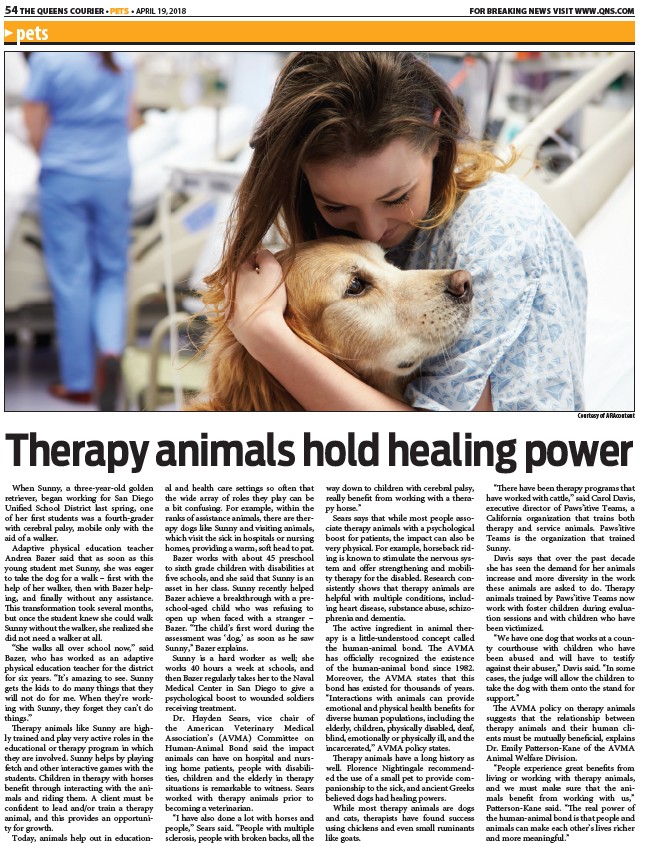
54 THE QUEENS COURIER • PETS • APRIL 19, 2018 FOR BREAKING NEWS VISIT WWW.QNS.COM
pets
Courtesy of ARAcontent
Therapy animals hold healing power
When Sunny, a three-year-old golden
retriever, began working for San Diego
Unifi ed School District last spring, one
of her fi rst students was a fourth-grader
with cerebral palsy, mobile only with the
aid of a walker.
Adaptive physical education teacher
Andrea Bazer said that as soon as this
young student met Sunny, she was eager
to take the dog for a walk – fi rst with the
help of her walker, then with Bazer helping,
and fi nally without any assistance.
Th is transformation took several months,
but once the student knew she could walk
Sunny without the walker, she realized she
did not need a walker at all.
“She walks all over school now,” said
Bazer, who has worked as an adaptive
physical education teacher for the district
for six years. “It’s amazing to see. Sunny
gets the kids to do many things that they
will not do for me. When they’re working
with Sunny, they forget they can’t do
things.”
Th erapy animals like Sunny are highly
trained and play very active roles in the
educational or therapy program in which
they are involved. Sunny helps by playing
fetch and other interactive games with the
students. Children in therapy with horses
benefi t through interacting with the animals
and riding them. A client must be
confi dent to lead and/or train a therapy
animal, and this provides an opportunity
for growth.
Today, animals help out in educational
and health care settings so oft en that
the wide array of roles they play can be
a bit confusing. For example, within the
ranks of assistance animals, there are therapy
dogs like Sunny and visiting animals,
which visit the sick in hospitals or nursing
homes, providing a warm, soft head to pat.
Bazer works with about 45 preschool
to sixth grade children with disabilities at
fi ve schools, and she said that Sunny is an
asset in her class. Sunny recently helped
Bazer achieve a breakthrough with a preschool
aged child who was refusing to
open up when faced with a stranger –
Bazer. “Th e child’s fi rst word during the
assessment was ‘dog,’ as soon as he saw
Sunny,” Bazer explains.
Sunny is a hard worker as well; she
works 40 hours a week at schools, and
then Bazer regularly takes her to the Naval
Medical Center in San Diego to give a
psychological boost to wounded soldiers
receiving treatment.
Dr. Hayden Sears, vice chair of
the American Veterinary Medical
Association’s (AVMA) Committee on
Human-Animal Bond said the impact
animals can have on hospital and nursing
home patients, people with disabilities,
children and the elderly in therapy
situations is remarkable to witness. Sears
worked with therapy animals prior to
becoming a veterinarian.
“I have also done a lot with horses and
people,” Sears said. “People with multiple
sclerosis, people with broken backs, all the
way down to children with cerebral palsy,
really benefi t from working with a therapy
horse.”
Sears says that while most people associate
therapy animals with a psychological
boost for patients, the impact can also be
very physical. For example, horseback riding
is known to stimulate the nervous system
and off er strengthening and mobility
therapy for the disabled. Research consistently
shows that therapy animals are
helpful with multiple conditions, including
heart disease, substance abuse, schizophrenia
and dementia.
Th e active ingredient in animal therapy
is a little-understood concept called
the human-animal bond. Th e AVMA
has offi cially recognized the existence
of the human-animal bond since 1982.
Moreover, the AVMA states that this
bond has existed for thousands of years.
“Interactions with animals can provide
emotional and physical health benefi ts for
diverse human populations, including the
elderly, children, physically disabled, deaf,
blind, emotionally or physically ill, and the
incarcerated,” AVMA policy states.
Th erapy animals have a long history as
well. Florence Nightingale recommended
the use of a small pet to provide companionship
to the sick, and ancient Greeks
believed dogs had healing powers.
While most therapy animals are dogs
and cats, therapists have found success
using chickens and even small ruminants
like goats.
“Th ere have been therapy programs that
have worked with cattle,” said Carol Davis,
executive director of Paws’itive Teams, a
California organization that trains both
therapy and service animals. Paws’itive
Teams is the organization that trained
Sunny.
Davis says that over the past decade
she has seen the demand for her animals
increase and more diversity in the work
these animals are asked to do. Th erapy
animals trained by Paws’itive Teams now
work with foster children during evaluation
sessions and with children who have
been victimized.
“We have one dog that works at a county
courthouse with children who have
been abused and will have to testify
against their abuser,” Davis said. “In some
cases, the judge will allow the children to
take the dog with them onto the stand for
support.”
Th e AVMA policy on therapy animals
suggests that the relationship between
therapy animals and their human clients
must be mutually benefi cial, explains
Dr. Emily Patterson-Kane of the AVMA
Animal Welfare Division.
“People experience great benefi ts from
living or working with therapy animals,
and we must make sure that the animals
benefi t from working with us,”
Patterson-Kane said. “Th e real power of
the human-animal bond is that people and
animals can make each other’s lives richer
and more meaningful.”